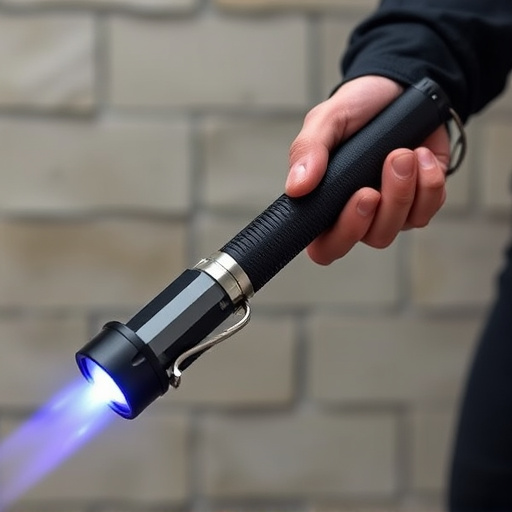Self-defense expandable batons, made of high-strength materials like aluminum or steel, are tactical tools that extend from 12 to 36 inches for increased striking power. Their performance is critical in neutralizing attackers without causing permanent injury, balancing impact force and strike velocity. Key factors affecting their effectiveness include material quality, design elements, weight distribution, and ergonomic features. Effective use requires understanding velocity metrics, proper grip, wrist movement, and follow-through to transfer energy efficiently. Training should focus on rapid baton extensions for swift strikes and force control to manage recoil and deliver powerful blows.
“In the realm of personal safety, understanding the capabilities of self-defense tools like expandable batons is paramount. This comprehensive guide delves into the intricate details of ‘self defense expandable baton’ performance metrics. We explore how impact force and velocity play pivotal roles in effective self-defense strategies. From dissecting the physics behind impact to practical training techniques, this article equips readers with knowledge to maximize the potential of these defensive tools.”
- Understanding Self Defense Expandable Batons: A Comprehensive Overview
- The Role of Impact Force in Self-Defense Weapons
- Analyzing Velocity Metrics for Optimal Defense Strategy
- Factors Influencing Baton Performance and Effectiveness
- Practical Applications and Training Techniques for Maximum Impact
Understanding Self Defense Expandable Batons: A Comprehensive Overview
Self-defense expandable batons, also known as tactical or extendable batons, are versatile tools designed for personal safety and security. These innovative devices offer a unique advantage in close-quarters combat, providing users with an additional layer of protection. The key to their effectiveness lies in the ability to extend and lock into place, transforming from a compact, easily concealable form into a powerful striking tool.
Comprised of high-strength materials like aluminum or steel, these batons feature a spring-loaded mechanism that allows for rapid deployment. When activated, the baton extends, typically reaching lengths ranging from 12 to 36 inches, providing a significant reach advantage. This extended length empowers users with greater striking power and the ability to keep aggressors at bay. The lock system ensures stability during use, preventing accidental retraction, which is crucial for effective self-defense scenarios.
The Role of Impact Force in Self-Defense Weapons
In the realm of self-defense weapons, the impact force generated by a tool can significantly influence its effectiveness. For instance, a self-defense expandable baton, due to its unique design and construction, is capable of delivering a powerful impact force when deployed. This force is crucial in neutralizing an assailant without causing permanent harm, reflecting the key balance between defense and minimal injury. The velocity at which the baton makes contact also plays a vital role; higher velocity can increase the effectiveness of the strike, making it a game-changer in close-quarters encounters.
Understanding these metrics—impact force and velocity—is essential for users to maximize the potential of their self-defense expandable batons. It allows them to choose the right tool for different scenarios and employ techniques that ensure safety while deterring potential threats. Moreover, recognizing the baton’s capabilities and limitations fosters responsible usage, making it an effective yet tactical option in personal defense situations.
Analyzing Velocity Metrics for Optimal Defense Strategy
When it comes to effective self-defense with a baton, understanding velocity metrics is key. These metrics help determine the optimal defensive strategy for users, ensuring they can deploy their self-defense expandable baton with maximum impact. By analyzing the speed and force generated by the baton strike, individuals can adapt their techniques to match different scenarios and opponents.
For instance, in close-quarters combat, a higher velocity strike may be effective for delivering a powerful blow quickly. In contrast, longer-range engagements might benefit from lower velocity but greater force to ensure accuracy without overdoing it, minimizing the risk of injury to oneself or bystanders. This nuanced understanding of baton dynamics empowers users to make tactical decisions in real-world situations, enhancing their ability to defend themselves effectively.
Factors Influencing Baton Performance and Effectiveness
The performance and effectiveness of a self-defense expandable baton are influenced by several key factors. One primary consideration is the material used; high-quality, durable metals or alloys ensure the baton maintains its shape and strength under stress, enhancing both impact force and velocity. The design, including the baton’s length, weight distribution, and locking mechanism, plays a crucial role in determining how easily it extends and retracts, directly impacting user control and speed during deployment.
Furthermore, the baton’s overall weight is essential; a balanced weight distribution allows for precise manipulation and swift movements, which can be critical in self-defense scenarios. Additionally, features like ergonomic grips and customizable accessories can improve comfort and versatility, enabling users to adapt the baton to their unique needs and fighting styles. These factors collectively contribute to the overall performance and utility of the self-defense expandable baton.
Practical Applications and Training Techniques for Maximum Impact
In practical applications, understanding baton impact force and velocity is paramount for effective self-defense with an expandable baton. Knowing how to generate and transfer maximum force can significantly enhance stopping power in real-life scenarios. Training techniques should focus on developing proper grip, wrist movement, and follow-through to ensure efficient energy transfer from the body to the baton.
For instance, practicing rapid extensions of the baton can increase velocity, allowing for swift strikes that disrupt an attacker’s balance and create opportunities for escape. Additionally, drills that emphasize controlling and redirecting force can help users manage recoil and deliver more powerful blows, making the expandable baton a versatile tool in self-defense situations.
In understanding the intricacies of self defense expandable batons, from their design to performance metrics like impact force and velocity, users can optimize defensive strategies. By analyzing these factors, individuals can choose the right baton for their needs and develop effective training techniques, ensuring maximum impact in real-world scenarios. Remember that proper training and a deep knowledge of these metrics are key to responsible self-defense practices.
